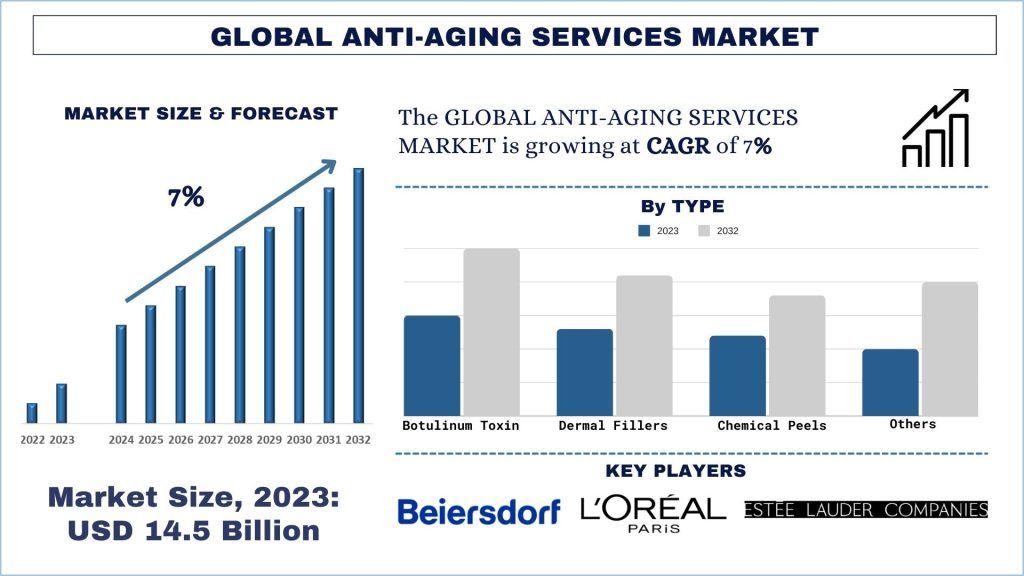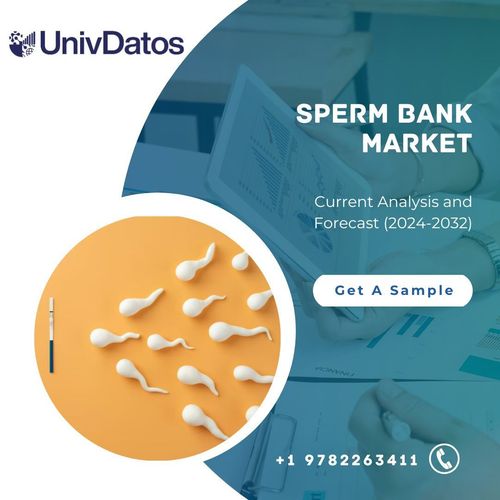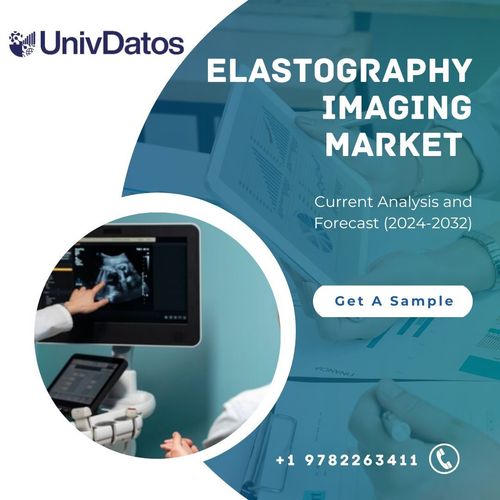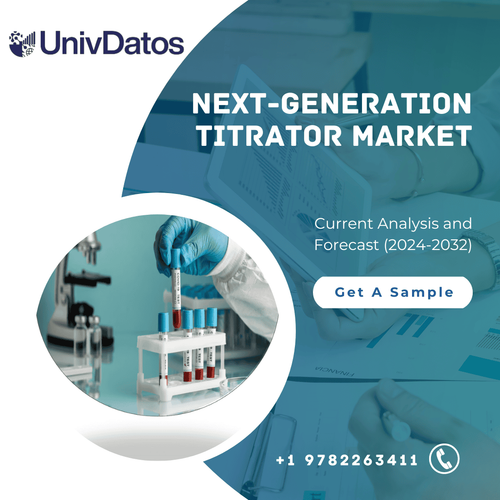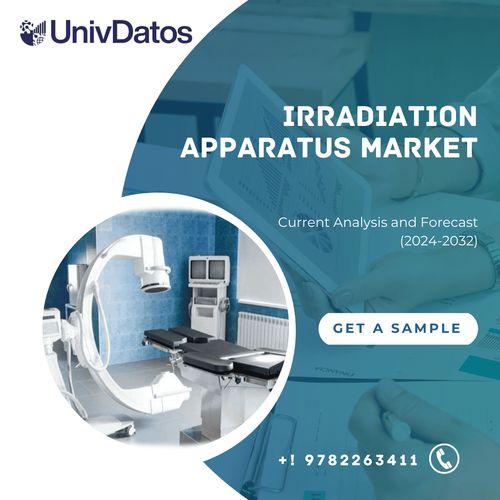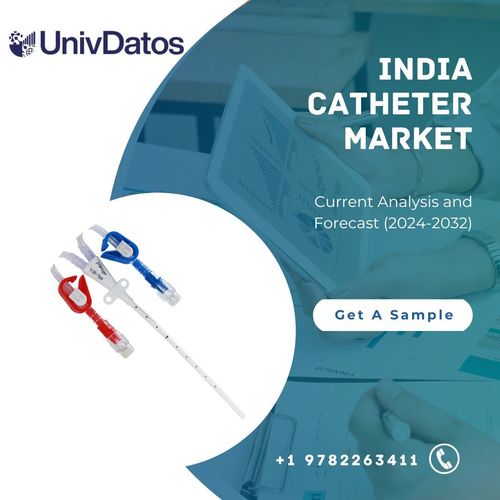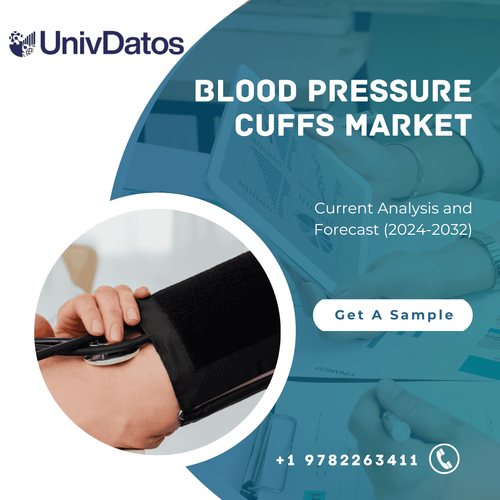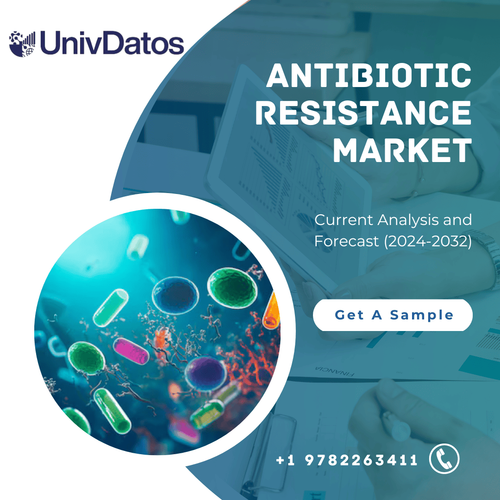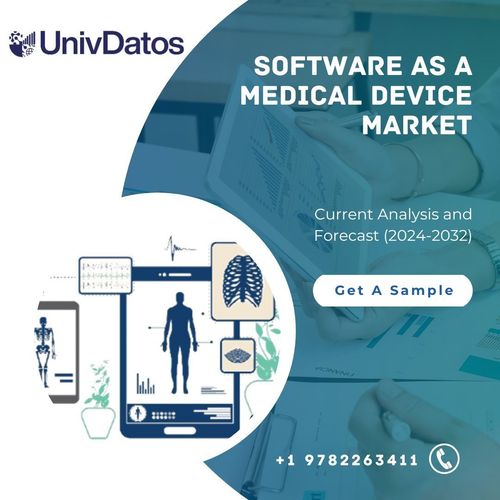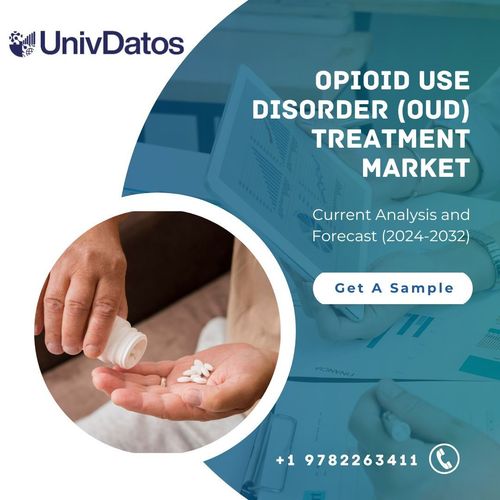Anti-Aging Services Market: Current Analysis and Forecast (2024-2032)
Emphasis on Type (Botulinum Toxin, Dermal Fillers, Chemical Peels, Others); Gender (Male, Female); Application (Fine Lines and Wrinkles, Aged Hand, Sagging Skin, others); Service Provider (Hospitals, Specialty & Dermatology Clinics, others); and Region/Country
Anti-Aging Services Market Size & Forecast
The Anti-Aging Services Market was valued at approximately USD 14.5 billion in 2023 and is expected to grow at a substantial CAGR of around 7% during the forecast period (2024-2032), owing to the increasing number of elderly individuals seeking anti-aging solutions.
Anti-Aging Services Market Analysis
Anti-aging services as a segment refers to a broad category of cosmetic services, therapies, and products aimed at slowing down and to a certain extent reversing the aging process which can be manifested as wrinkles, fine lines, loose skin, and volume loss. These services usually involve non-surgical procedures such as injections for wrinkles, lip fillers, laser treatments, face peels, dermabrasion, and facials and skincare products designed to enhance skin quality, dimensions, and resilience.
To facilitate its growth and additions to Anti-Aging Services Market penetration, innovations in non-invasive and minimally invasive procedures are available, making anti-aging treatments more appealing because of short recovery than performing general surgeries. For instance, in January 2023, Seragon Biosciences, Inc. introduced a new product called RESTORIN, a superior class of nutraceuticals for healthy aging. RESTORIN incorporates several patented innovations from Harvard University, Mayo Clinic, and Scripps Research to increase the amount of cellular nicotinamide adenine dinucleotide (NAD+) and promote the stimulation of senolytics.
Furthermore, the demand for anti-aging services increases, and more healthcare and cosmetic clinics for services to enter the market and compete. It can further encourage innovation; in the process, there could be enhanced services and lower prices in the market.
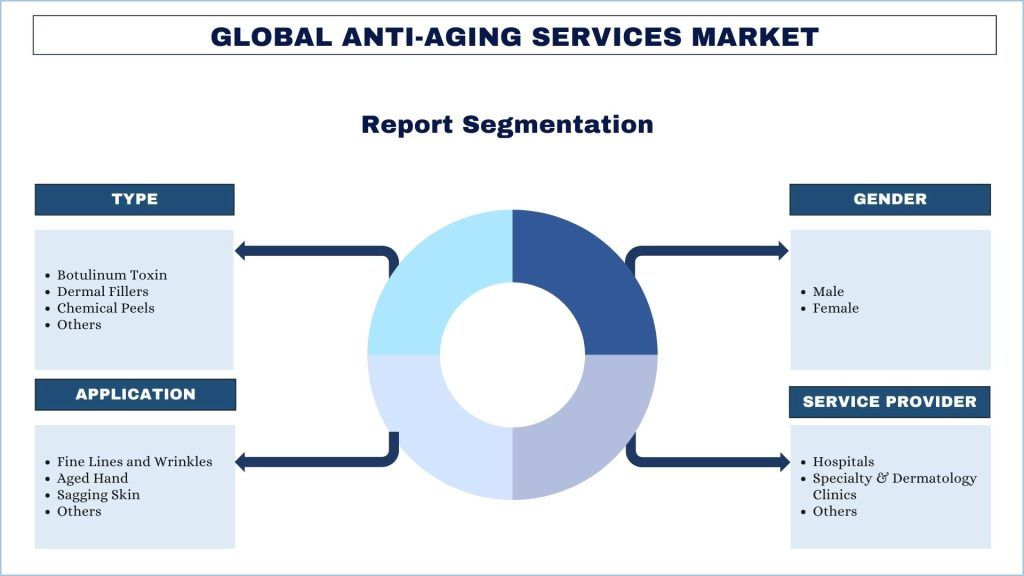
Anti-Aging Services Market Trends
This section discusses the key market trends influencing the various segments of the Anti-Aging Services Market as identified by our research experts.
Botulinum toxin Anti-Aging Services Transforming Industry:
Botulinum toxin is a highly effective remedy that is responsible for decreasing the appearance of wrinkles and fine lines. Botulinum toxin is popular among people who want to have smooth skin and look young. Botox then works perfectly for anyone, male or female, who wants to deal with aging symptoms without undergoing major surgery and with relatively fast results. Furthermore, the development of aesthetic treatments and products remains progressive as they provide people with an alternative way to attain fresher and smoother skin without resorting to surgery. The stringent regulatory measures implemented by the FDA offer confidence not only to the consumers but also to health workers in the quality and appropriateness of the product for aesthetic procedures. As per the FDA, in May 2024, FDA-approved Botox is available in 100- and 200-unit vials. FDA-approved Botox Cosmetic is available in 50- and 100-unit vials. The FDA-approved Botox products display the active ingredient as “OnabotulinumtoxinA” on the outer carton and vial.
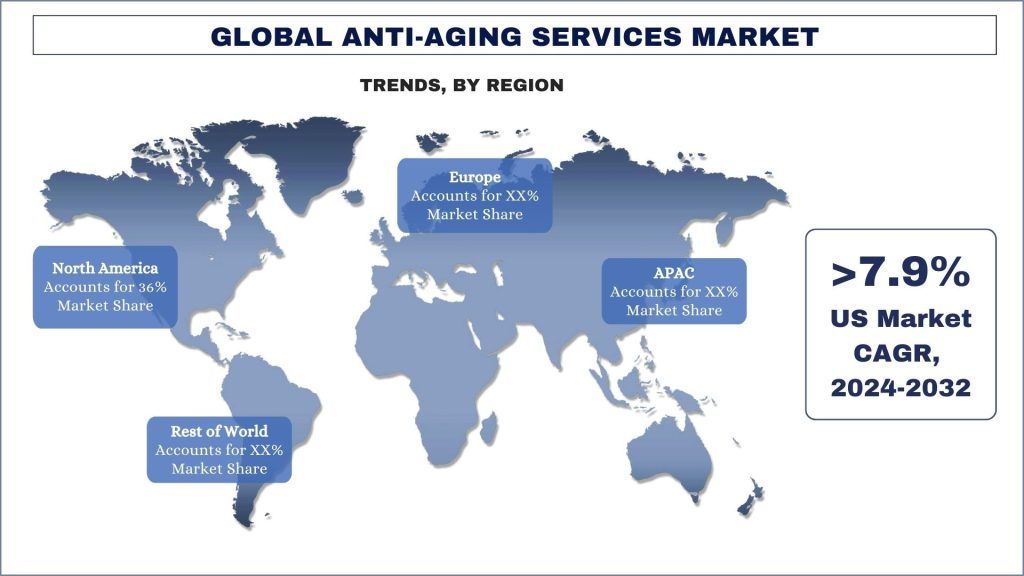
North America leads the market in 2023
In 2023, North America occupied a large share of the total Anti-Aging Services Market, driven by technology, population, demography, and attitude toward aging. Besides this, the rise in the geriatric population in North America and the need to look young and beautiful is providing the push towards getting anti-aging services. Further, technological advancements have brought out various new-age anti-aging products and services such as skin care products, beauty procedures, facelifts, and stem cell therapies. In addition, companies operating in North America could thus venture into mergers and acquisitions to diversify their service portfolio, hence the need for anti-aging services. For example, L’Oréal announced the acquisition on September 23, 2022, Skinbetter Science, an American skincare brand dedicated to physicians that is grounded on advanced dermatological science, for instance, patented efficacious ingredients as well as luxurious sensorial textures.
Anti-Aging Services Industry Overview
The Anti-Aging Services Market is competitive, with several global and international market players. The key players are adopting different growth strategies to enhance their market presence, such as partnerships, agreements, collaborations, new product launches, geographical expansions, and mergers and acquisitions. Some of the major players operating in the market are Beiersdorf AG; L’Oréal Paris; The Estée Lauder Companies; Shiseido Co., Ltd; Insilico Medicine; Nu Skin International, Inc.; Johnson & Johnson Services, Inc.; Life Biosciences, Inc.; Alma Lasers, Cutera, Inc.
Anti-Aging Services Market News
- In April 2024, Beiersdorf and Rubedo Life Science entered a multi-year strategic partnership to develop a breakthrough anti-aging solution for the global face care market. This partnership represents a fusion of Beiersdorf’s leadership in skin care innovation with Rubedo’s complementary expertise in targeting cellular senescence.
- In January 2023, Seragon Biosciences, Inc. introduced a new product called RESTORIN, a superior class of nutraceuticals for healthy aging. RESTORIN incorporates several patented innovations from Harvard University, Mayo Clinic, and Scripps Research to increase the amount of cellular nicotinamide adenine dinucleotide (NAD+) and promote the stimulation of senolytics.
- In September 2022, L’Oréal signed an agreement to acquire Skinbetter Science, a physician-dispensed American skincare brand backed by cutting-edge dermatological science, combining patented efficacious ingredients with luxurious sensorial textures.
Anti-Aging Services Market Report Coverage
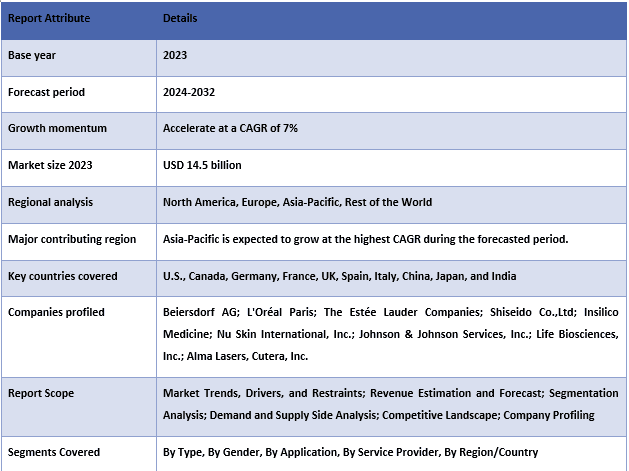
Reasons to buy this report:
- The study includes market sizing and forecasting analysis validated by authenticated key industry experts.
- The report presents a quick review of overall industry performance at one glance.
- The report covers an in-depth analysis of prominent industry peers with a primary focus on key business financials, product portfolios, expansion strategies, and recent developments.
- Detailed examination of drivers, restraints, key trends, and opportunities prevailing in the industry.
- The study comprehensively covers the market across different segments.
- Deep dive regional level analysis of the industry.
Customization Options:
The global Anti-Aging Services Market can further be customized per the requirement or any other market segment. Besides this, UMI understands that you may have your own business needs; hence, feel free to connect with us to get a report that completely suits your requirements.
Table of Contents
Research Methodology for the Anti-Aging Services Market Analysis (2024-2032)
Analyzing the historical market, estimating the current market, and forecasting the future market of the global Anti-Aging Services Market were the three major steps undertaken to create and analyze the adoption of Anti-Aging Services in major regions globally. Exhaustive secondary research was conducted to collect the historical market numbers and estimate the current market size. Secondly, numerous findings and assumptions were taken into consideration to validate these insights. Moreover, exhaustive primary interviews were also conducted, with industry experts across the value chain of the global Anti-Aging Services Market. Post assumption and validation of market numbers through primary interviews, we employed a top-down/bottom-up approach to forecasting the complete market size. Thereafter, market breakdown and data triangulation methods were adopted to estimate and analyze the market size of segments and sub-segments of the industry. Detailed methodology is explained below:
Analysis of Historical Market Size
Step 1: In-Depth Study of Secondary Sources:
Detail secondary study was conducted to obtain the historical market size of the Anti-Aging Services Market through company internal sources such as annual reports & financial statements, performance presentations, press releases, etc., and external sources including journals, news & articles, government publications, competitor publications, sector reports, third-party database, and other credible publications.
Step 2: Market Segmentation:
After obtaining the historical market size of the Anti-Aging Services Market, we conducted a detailed secondary analysis to gather historical market insights and share for different segments & sub-segments for major regions. Major segments are included in the report, such as type, gender, application, service provider, and region. Further country-level analyses were conducted to evaluate the overall adoption of testing models in that region.
Step 3: Factor Analysis:
After acquiring the historical market size of different segments and sub-segments, we conducted a detailed factor analysis to estimate the current market size of the Anti-Aging Services Market. Further, we conducted factor analysis using dependent and independent variables such as type, gender, application, service provider, and regions of the Anti-Aging Services Market. A thorough analysis was conducted of demand and supply-side scenarios considering top partnerships, mergers and acquisitions, business expansion, and product launches in the Anti-Aging Services Market sector across the globe.
Current Market Size Estimate & Forecast
Current Market Sizing: Based on actionable insights from the above three steps, we arrived at the current market size, key players in the Global Anti-Aging Services Market, and market shares of the segments. All the required percentage shares split, and market breakdowns were determined using the above-mentioned secondary approach and were verified through primary interviews.
Estimation & Forecasting: For market estimation and forecast, weights were assigned to different factors including drivers & trends, restraints, and opportunities available for the stakeholders. After analyzing these factors, relevant forecasting techniques i.e., the top-down/bottom-up approach were applied to arrive at the market forecast for 20302 for different segments and sub-segments across the major markets globally. The research methodology adopted to estimate the market size encompasses:
- The industry’s market size, in terms of revenue (USD) and the adoption rate of the Anti-Aging Services Market across the major markets domestically
- All percentage shares, splits, and breakdowns of market segments and sub-segments
- Key players in the global Anti-Aging Services Market in terms of products offered. Also, the growth strategies adopted by these players to compete in the fast-growing market.
Market Size and Share Validation
Primary Research: In-depth interviews were conducted with the Key Opinion Leaders (KOLs) including Top Level Executives (CXO/VPs, Sales Head, Marketing Head, Operational Head, Regional Head, Country Head, etc.) across major regions. Primary research findings were then summarized, and statistical analysis was performed to prove the stated hypothesis. Inputs from primary research were consolidated with secondary findings, hence turning information into actionable insights.
Split of Primary Participants in Different Regions
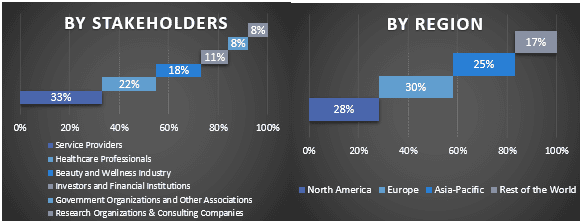
Market Engineering
The data triangulation technique was employed to complete the overall market estimation and to arrive at precise statistical numbers for each segment and sub-segment of the Global Anti-Aging Services Market. Data was split into several segments and sub-segments after studying various parameters and trends in the type, gender, application, service provider, and regions of the Global Anti-Aging Services Market.
The main objective of the Global Anti-Aging Services Market Study
The current & future market trends of the global Anti-Aging Services Market were pinpointed in the study. Investors can gain strategic insights to base their discretion for investments on the qualitative and quantitative analysis performed in the study. Current and future market trends determined the overall attractiveness of the market at a regional level, providing a platform for the industrial participant to exploit the untapped market to benefit from a first-mover advantage. Other quantitative goals of the studies include:
- Analyze the current and forecast market size of the Anti-Aging Services Market in terms of value (USD). Also, analyze the current and forecast market size of different segments and sub-segments.
- Segments in the study include areas of the type, gender, application, service provider, and regions.
- Define and analyze the regulatory framework for the anti-aging services
- Analyze the value chain involved with the presence of various intermediaries, along with analyzing customer and competitor behaviors of the industry.
- Analyze the current and forecast market size of the Anti-Aging Services Market for the major region.
- Major countries of regions studied in the report include Asia Pacific, Europe, North America, and the Rest of the World
- Company profiles of the Anti-Aging Services Market and the growth strategies adopted by the market players to sustain in the fast-growing market.
- Deep dive regional level analysis of the industry
Frequently Asked Questions FAQs
Q1: What are the Anti-Aging Services' current market size and growth potential?
Q2: What are the driving factors for the growth of the Anti-Aging Services market?
Q3: Which segment has the largest share of the anti-aging services market by type?
Q4: What are the trends in the Anti-Aging Services market?
Q5: Which region will dominate the Anti-Aging Services market?
Related Reports
Customers who bought this item also bought

